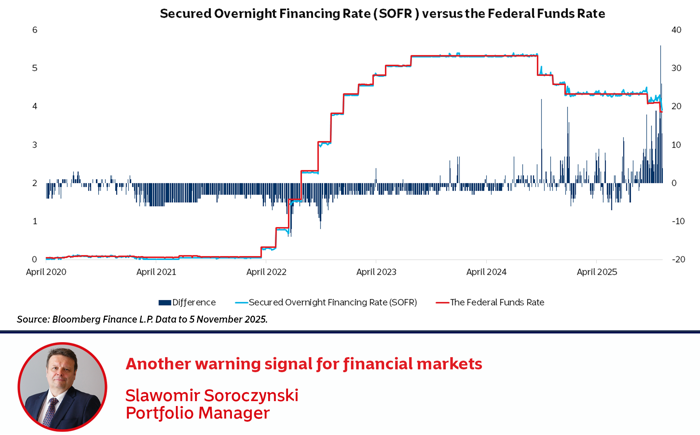
What this chart shows
The chart illustrates two key interest rates in the United States: The Federal Funds Rate and the Secured Overnight Financing Rate (SOFR).
Why this is important
SOFR, which replaced LIBOR (London Interbank Offered Rate) is widely used as the benchmark for short-term US dollar funding costs and serves as the primary reference rate for loans, derivatives, and other financial contracts.
From a fundamental perspective, SOFR should typically trade below the Federal Funds Rate, as it represents the least risky instrument from a credit standpoint. Data from 2020 to 2024 largely supports this assumption. However, readings from 2025 reveal a concerning divergence.
Recently, SOFR has risen significantly relative to the effective Federal Funds Rate. This shift reflects structural factors in short-term funding markets rather than changes in monetary policy. A key driver is the accumulation of large leveraged long positions in US Treasury cash bonds, financed through the repo market, as part of a popular futures arbitrage strategy. In this trade, investors buy Treasury securities and sell Treasury futures to exploit minor pricing discrepancies, relying heavily on repo financing.
The surge in demand for secured overnight funding has driven SOFR higher. In contrast, the Federal Funds Rate—an unsecured interbank rate less sensitive to collateralized leverage—has remained relatively stable. This divergence underscores how market positioning and liquidity dynamics within the repo market can temporarily distort the spread between SOFR and the Federal Funds Rate.
From a technical standpoint, a prolonged distortion in funding conditions may lead to forced liquidation of positions. This, in turn, could trigger a broader unwinding of leveraged trades across a wider range of asset classes.
Global growth faces mounting pressure: US shutdown and UK fiscal tightening rattle confidence, EU braces for geopolitical risks, China and Japan stumble economically, while commodity shifts and diplomatic moves heighten global uncertainty.

-
The federal government shutdown continues but a group of Democrats broke with their party and voted to support a deal to end the longest-ever US government shutdown. The Senate voted 60-40 to re-open government in a procedural test vote at the weekend which requires the consent of all members to advance.
-
New York City elected Zohran Mamdani as mayor, marking a generational and political shift in the nation’s largest city.
-
The Federal Reserve faces poor visibility as key labour-market data (jobs, openings) are delayed by the shutdown - complicating policy decisions.
-
The Federal Reserve faces poor visibility as key labour-market data (jobs, openings) are delayed by the shutdown - complicating policy decisions.

-
The UK economy is forecast to slow sharply: forecasts point to growth next year of under 1 % due to looming tax rises and weakening business investment.
-
Ahead of the budget (26 November), speculation is intensifying about tax hikes (on homes, pensions, banks) and constrained spending – adding to business and consumer caution.
-
Business confidence is reported to be at record lows as firms brace for regulatory/tax-policy risk and structural economic burdens (productivity, cost pressures).
-
Politically, the government is tightening its fiscal discipline messaging: ministers and departments are being told to “live within their means” as borrowing costs rise and fiscal credibility is under scrutiny.

-
The European Commission and European member states remain cautious about deepened trade/ investment ties with China: Beijing has flagged renewed agreements, but Brussels remains wary of trade imbalance, critical-minerals dependency and geopolitical alignment.
-
Germany’s coalition government plans to review “security-relevant” trade with China (including energy & raw materials) in the coming period, reflecting mounting geopolitical-economic concern.
-
The European Central Bank (ECB) kept interest rates unchanged ahead of the week, as euro-area growth remains very modest (~0.2 % q/q) and inflation is under pressure.
-
The European Parliament and its committees are prioritising rule-of-law issues (notably regarding certain member states) while also debating the next long-term EU budget and the bloc’s “own-resources” decision.

-
Chinese stocks continue to lag: the MSCI China index dropped ~3.9 % in recent measurement, pointing to investor concern about growth prospects and external headwinds.
-
Japan’s economy is projected to have contracted in Q3 2025 (annualised –2.5 %), with exports down (~2.2 %) – hit by US tariffs and weaker overseas demand.
-
The US and UK removed sanctions on Syrian President Ahmad al-Sharaa on Friday, a day after the United Nations Security Council did the same ahead of his meeting with President Trump next week, with the European Union confirming it would follow suit.
-
Commodity and oil markets are in focus: with OPEC + signalling a modest output rise for December then a pause next quarter, global supply/demand balances are under review.
